AudioReputation is reader-supported. When you buy through links on our site, we may earn an affiliate commission Learn More
In this article, we’ll explore the crucial relationship between speaker and amplifier wattage. Understanding that a speaker’s wattage indicates its power handling capacity, and an amplifier’s wattage shows its power delivery capability, we emphasize using an amplifier with roughly double the wattage of the speaker. This setup ensures optimal sound quality without distortion. We also discuss other key specifications like impedance and sensitivity, and provide tips on how to match speakers and amplifiers effectively, considering room size and usage needs.
To some people, looking for the matching amp for their stereo speaker system and trying to achieve the best possible synergy, is an adventure. They love doing it, they love trying different combinations, and they enjoy every moment of that journey. To others, it’s just too confusing and annoying. They don’t know what to look for, what’s acceptable and what’s not, what specs are important, and what all those specs even mean.
Our article is here to answer not only the question from the title but also all the other questions related to amp/speaker matching. Even if you don’t have any relevant knowledge about audio equipment, you don’t have to worry. After reading our short guide, you will know exactly what to look for.
Let’s start with the basic terminology and most important specifications.
Table of Contents
- Should Speaker Wattage Be Higher Than Amp Wattage?
- What Is Meant by Speaker Wattage and Amp Wattage?
- What Are the Most Important Specifications and What’s Their Meaning?
- Matching Amplifier and Speakers – What to Look for In Terms of Specifications
- Matching Amplifier and Speakers – Other Important Considerations
- Things You Shouldn’t Match
- What to Do if All This Is Just Too Complicated for You?
- FAQs
- Conclusion
Should Speaker Wattage Be Higher Than Amp Wattage?
No, It is always recommended to use approximately twice as much amplifier power as the speaker’s power rating. More watts may provide more bass, but only if the amplifier you’re currently using is insufficiently strong for the speakers you’re using.
What Is Meant by Speaker Wattage and Amp Wattage?
The wattage of a speaker refers to how much power it can handle without audible distortion. The higher the wattage of the speakers, the more power they can receive from the amplifier and, consequently, can be turned louder without any loss in sound quality.
In an amplifier, the wattage refers to how much power it will deliver to the speakers. As mentioned before, it’s always a great idea to have spare power in your amplifier, that is, a bit more wattage than your speakers actually need to function properly.
While larger rooms require speakers with higher watts, it can be overpowering in smaller audio setups, so you should keep the layout of your set in mind when shopping.
Also, by ensuring you’re providing enough wattage to your speakers, you will have a much better sound quality across all of the frequency spectrum, and a smoother listening experience.
Both specifications are usually stated in the speaker’s/amp’s owner’s manual or manufacturer’s website.
What Are the Most Important Specifications and What’s Their Meaning?
The first step to getting a better understanding of the process of finding the right amp for your speakers is understanding the specifications. To keep things simple, our focus will be centered on the three most important specs – power rating, impedance, and sensitivity. That being said, you shouldn’t think that other specifications are irrelevant, but we would need a much longer article to address them all and explain the meaning of each spec. For now, let’s just say that you have to pay attention to power, impedance, and speaker sensitivity.
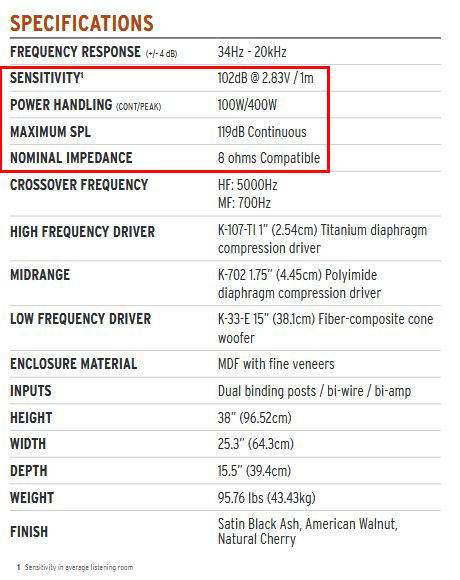
Klipsch CORNWALL IV speaker specifications (Klipsch HERITAGE series)
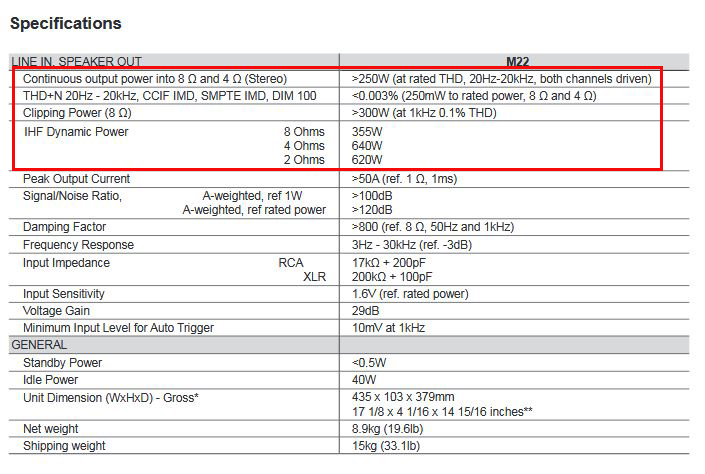
NAD M22 Power Amp Specifications
Power Ratings
You will find power ratings in both – speaker specs and amp specs. In the speaker specs, the power rating represents the power input and, in the amp’s specs, it represents the power output. In both cases, the value is expressed in Watts (W).
When it comes to speakers, this power rating tells you the amount of power a speaker can handle. Depending on the manufacturer, you can see either max RMS power rating (this is the amount of power a speaker can handle continuously – over long periods of time) or Peak power rating aka Dynamic power (this is the amount of power a speaker can handle in bursts, for a very short period of time, usually less than a millisecond). In some cases, you will find both values. Rarely, you will also find the minimum recommended RMS power.
Some renowned manufacturers (Klipsch, Martin Logan, DALI, and many others) have adopted a new approach – instead of multiple values, they give you the recommended amplification (recommended amp power or continuous power handling) as a range. So, you will see something like 50 W – 200 W (see the Klipsch CORNWALL IV specs list above).
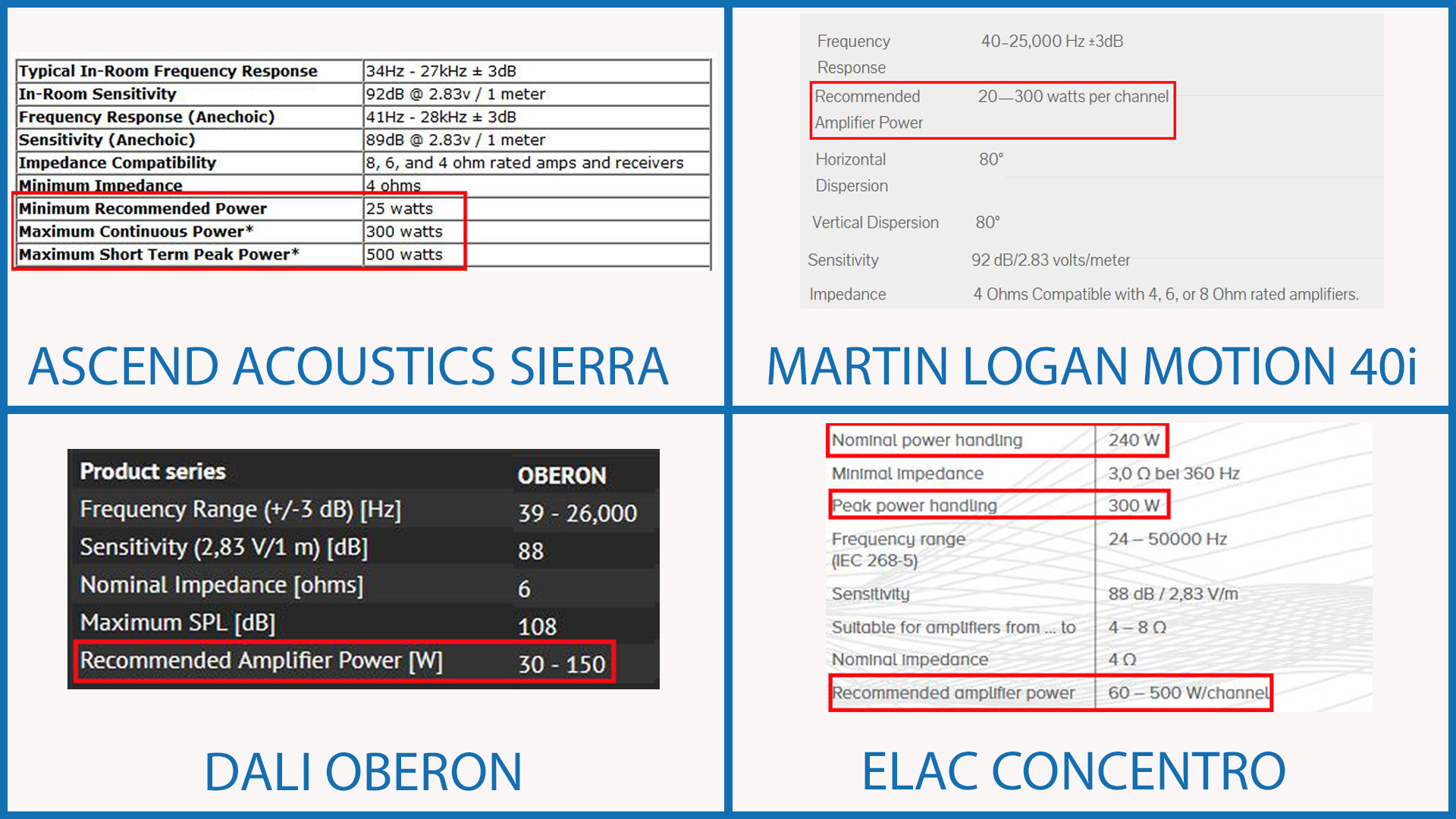
Different speaker manufacturers publish their speakers’ power ratings in different ways
When it comes to amplifier specs, power rating represents the amount of power the amp can push into a certain load (speaker). So, it’s a power output for the given impedance. Renowned manufacturers will publish continuous power outputs for every impedance their amps are compatible with (or, in some cases, just outputs for 4Ω and 8Ω loads). Most of them will also publish dynamic/peak power outputs for different loads.
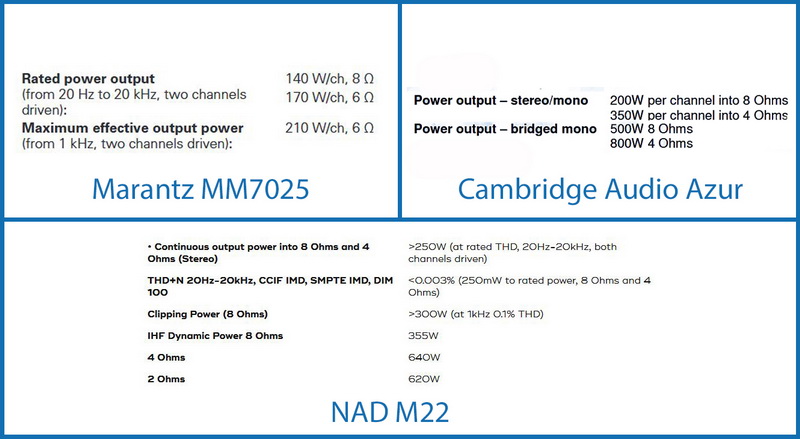
It’s pretty obvious why the power ratings are important – you have to find the amp that can supply enough power to your speakers. That’s the whole point of power ratings.
Also Read: 5 Best Portable Voice Amplifiers For Teachers.
Impedance
Impedance is also published in both – amp specs and speaker specs. It’s expressed in Ohms (Ω), and it represents the resistance of electrical components inside your speaker to AC current coming from the amplifier.
When it comes to speakers, the impedance (or nominal impedance) is usually given as a single number – something like 4Ω or 8Ω (these are the most common values, but it can also be 3 or 6Ω). This specification basically tells you how hard the speaker is to drive or what kind of load it represents to the amplifier.
Without going too deep into the physics and math, let’s just say that, based on Ohm’s Law (I=VR, I-current, V-voltage, R-resistance), low-impedance speakers are harder to drive than high-impedance speakers because they draw more current while maintaining the same voltage to the speaker. So, a 4Ω speaker is harder to drive than an 8Ω speaker. That’s all you need to know.
Recommended Reading :
- What Are Stereo Amplifiers and How Do They Work?
- Difference Between AC & DC Amplifiers
- Ways to Connect Speakers to an Amp
When it comes to amps, the impedance is given as a range, and it basically tells you what speakers that amp is capable of driving. So, if the impedance range is given like this – 4Ω-8Ω, it means that the amp is capable of driving speakers with 4Ω, 6Ω, and 8Ω impedance.
Impedance is closely related to power ratings and, when you look at the amp specs, you will not only see the range of compatible impedances, but also the power output for different nominal impedances. Why? Well, because the power output changes with the impedance – it’s higher when the impedance is lower.
If you look at the image above, you will notice that Marantz MM7025 pushes 140 Wpc @ 8Ω and 170 Wpc @ 4Ω.
So, it’s important for you to remember that the power output of an amp is always given for a certain impedance. It’s not a constant value, and it’s not the same for every load.
Sensitivity
Speaker sensitivity is also an important factor when it comes to the overall performance of your stereo system.
It is either expressed in dB @1W/1m or dB @2.83V/1m. This value is often described as the measure of loudness. To be more precise, the sensitivity can give you the idea of how loud a pair of speakers can be for the given power input. And it can tell you which one of two speakers will be louder when supplied with the same amount of power.
So, the sensitivity is not exactly the measure of loudness. At least, not on its own. If you are trying to figure out how loud a speaker can be, you have to consider two values – speaker’s sensitivity and max RMS power input.
There’s a simple rule that can help you calculate the max loudness (aka max SPL) of a speaker – when you double the wattage, the SPL increases by 3dB. So, if you know the sensitivity (the SPL level for 1W of power) and the max RMS, just keep doubling the power (2W, 4 W, 8 W, 16 W, 32 W) and adding 3dB to the sensitivity until you come to the max RMS power input. Some manufacturers (like DALI or KEF) will publish the max SPL, so you don’t have to calculate it on your own, but that’s not always the case.
Another important thing to know is that there’s a relationship between perceived loudness and distance (between you and your speakers). When you double the distance, the perceived SPL is decreased by 6dB. So, if the SPL, measured at 1m distance, is 108dB, it will be 102dB at 2m, 96dB at 4m, etc.
The last thing we want you to know is that when the sound pressure level (loudness) of some sound is increased by 10dB, that sound is perceived by the average ear as twice as loud.
You are supposed to consider all these correlations (between SPL and power input, SPL and distance, SPL and your ears) when looking for the right pair of speakers and for the right amp. If you neglect these facts, you may end up with a stereo system (or a home theater system) that is simply not good enough for the intended purpose or for the room you want to use it in.
To find out more about sensitivity and about different ways of measuring sensitivity and loudness, check out our article about speaker sensitivity.
Matching Amplifier and Speakers – What to Look for In Terms of Specifications
When matching amplifiers and speakers, it’s important to consider specifications like power rating, impedance, and sensitivity. The amplifier’s power should ideally be about twice the speaker’s wattage to prevent distortion and ensure quality sound. Additionally, the impedance and sensitivity of both should be compatible to ensure efficient power usage and optimal audio performance.
Once you understand the meaning and significance of power ratings, impedance matching, and sensitivity, it becomes much clearer what to look for. So, let’s see how the process of finding the right amp for your speakers is supposed to look like.
As discussed in the previous section, three values are important – power rating, impedance, and speaker sensitivity. Find those three values in your speakers’ specification list, and we can move on and try to find the amp with matching specs.
To make it easier to follow, let’s try to find the perfect match for Martin Logan Motion 40i floorstanding speakers.
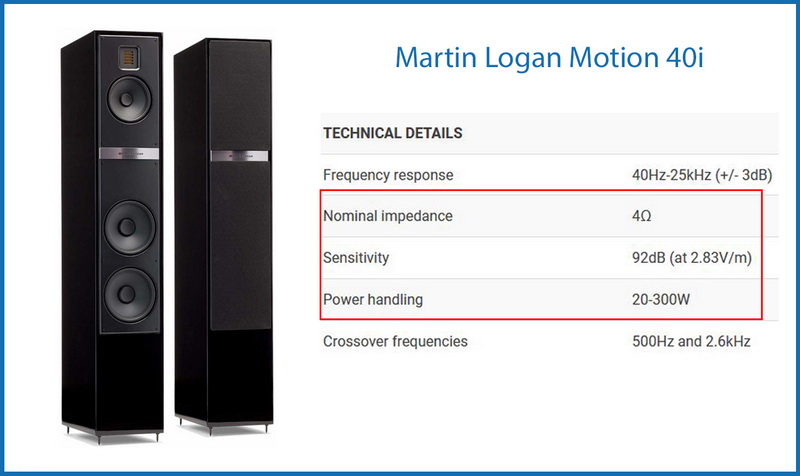
As you can see from the image, the nominal impedance of the Motion 40i is 4Ω, the sensitivity is 92dB (@ 2.83/m), and the recommended amp output is 20-300W. The sensitivity is pretty high (92dB) so once you find your right amp, you can be assured that you can get a pretty loud sound, even at low volume (114dB at full volume at 1m/3ft distance or 102dB at 4m/13ft distance).
So, we are looking for an amp that is compatible with 4Ω speakers and that can output at least 20W per channel, but preferably something with a power output of at least 150W at 4Ω (since our speaker can handle 300W). It’s even better if you can afford something more powerful.
All three amps from one of our previous examples (Marantz MM7025, NAD M22, Cambridge Audio Azur) are more than capable of driving a pair of Motion 40i speakers. NAD M22 and Cambridge Audio Azur are maybe even a bit too capable (250W RMS with 640W peak in the case of NAD M22 and even higher output in the case of Cambridge Audio Azur).
There’s a bunch of other viable choices. You could try PS Audio Stellar 300 (300W RMS @ 4Ω) or NAD C 275BEE (150W RMS at 4Ω with 410W peak). It doesn’t even hurt if the amp output is 1.5 or 2x higher than the recommended as long as you are reasonable enough not to raise the volume all the way up. But, if you want to be safe, just stay within the limits. If the recommended amplification for your speakers is 20-300W, buying an amp with 150W RMS output into 4Ω will be just fine.
Matching Amplifier and Speakers – Other Important Considerations
People often pay too much attention to specs and forget about other important things that are not closely related to the technical characteristics of the amp or of the speakers. Things like speaker placement, room size, and intended purpose, should also be considered when looking for the right amp/speaker combo. Tonal characteristics of the amplifier should also be considered – even if two amps have the same power ratings for the given impedance, they won’t sound the same.
Room Size and Acoustic Characteristics of the Environment
What’s good enough for a small room (like 10x10ft), in terms of speaker size, speaker sensitivity, and amp output, might not be good enough for large rooms with higher ceilings. Depending on the size of your room and the distance between your listening position and speakers, you may have to consider buying larger speakers and/or more powerful amp.
You can find numerous SPL calculators online, and they can help you figure out what kind of speaker and amp you need for your room.
Purpose
Are you going to use your stereo system for private listening at moderate volumes or for movie watching or for parties? The intended purpose must be considered, too. If you are not going to use it for parties and are not a fan of extremely loud sound, buying smaller speakers or an amp with a lower power output is a viable option.
If you, on the other hand, are going to use your stereo system for parties, you need higher volume and, consequently, you need more power and larger speakers.
Tonal Characteristics of the Amplifier (and of the Speakers)
Even if two amps have identical power outputs and maybe even some other similarities, they will not deliver the same kind of sound when paired with the same pair of speakers. The same applies to one amplifier and two sets of speakers with identical specs.
That’s why you should always consider the tonal characteristics of your amp and your speakers. How? Well, there’s only one way to do that properly – a real-life test. So, once you find the amp that’s compatible with your speakers (the one that’s compatible with your speakers’ impedance and delivers the right amount of power), go to your local audio store and ask if you can test the amplifier you want to buy. If possible, test it with speakers that are similar or the same as yours. If you like the sound and are satisfied with the volume levels, the only thing left to do is buy the damn thing.
Things You Shouldn’t Match
If you’re a reasonable and careful person, this section of our article is probably redundant, but we still feel it’s important to mention some things you shouldn’t do.
Lower-Impedance Speakers with Higher-Impedance Amps
You should never match a low-impedance speaker with an amp that doesn’t support that impedance. So, connecting a 2Ω or 3Ω speaker to a 4Ω-8Ω amp is a BIG NO-NO.
The reason is simple. Lower-impedance speakers represent greater load, they draw more current, resulting in increased power output. If you, god forbid, raise the volume and keep raising it, you will get to the point when the amplifier simply can’t produce enough current/power.
So, what happens then? Best case scenario – the amp’s protection circuit kicks in, turns the amp off and prevents any damage. If you are not that lucky, the amp fuse will blow, or, even worse, you will lose your amp forever.
High-Wattage and Low-Sensitivity Speakers with Low-Wattage Amp
Relatively small discrepancies should not be a problem, especially with high-sensitivity speakers. For example, you can use a 50W or a 30W (per channel) amp to drive speakers that can handle 100W or 150W, especially if their sensitivity is above 90dB (1W/1m). If the speakers’ sensitivity is high, it means that you don’t need a whole lot of power to reach some pretty high volume levels.
However, when the situation is extreme – whey you have a pair of speakers with relatively low sensitivity (around 85dB) but can handle very high wattages (up to 300W), and you connect it to an amp that can output up to 30W per channel, you may experience some issues.
The problem with this scenario is that your speakers are not only too big but also not sensitive enough so you can’t reach reasonable listening volumes without pushing your amp harder. If you push it too hard, you can overdrive your amp and cause it to deliver the amount of power that is higher than its actual power rating, which leads to clipping, which could damage your speakers and your amplifier.
Amplifier Clipping
Extremely High-Wattage Amp with Extremely Low-Wattage Speakers
We are, again, talking about extreme situations. Small discrepancies are not a problem. They are even desirable (because of the headroom). Even if the amp can output 2x more than your speaker can handle, it’s not a problem. Even if it’s 3x more, as long as you are reasonable and use common sense to evaluate the sound output and recognize when the sound becomes distorted, you will be fine. And, the good thing is that you will always have enough headroom, which can be very useful when listening to music with a high dynamic range.
However, if your amp pushes much more power than your speakers can handle (if your turn up the volume way too much), that excessive power will turn into heat, and that heat could fry the voice coil.
What to Do if All This Is Just Too Complicated for You?
If you don’t want to deal with speakers, amps, and their specifications, there’s always an easier solution. And, in this case, it’s not even a bad solution. You can get a pair of great-sounding active speakers. Active or powered speakers are speakers that already have a built-in matching amp inside them and don’t require external amplification.
So, you just find the speakers you like, buy them, bring them home, plug them in, and turn them on. You don’t have to spend hours going through specs and testing equipment.
FAQs
A: It doesn’t have to be, but it doesn’t hurt if it is. That will give you more headroom, and that’s always a good thing. However, huge discrepancies could cause a problem, and you may damage your speakers if the amount of power sent from your amp is way higher than your speaker can handle.
A: Slightly higher than what the speaker can handle should not be a problem. Much higher could fry the voice coil.
A: It is impossible to answer this question without considering other parameters. You should also consider speaker sensitivity, amplifier power output, as well as room characteristics, and intended purpose.
A: The majority will probably say that it’s better to overpower the speakers. Having a little bit more power than necessary could have a positive effect on the headroom, which is always a good thing. However, having too much power or too little power could sometimes cause damage, especially if the difference between the given power and required power is too big.
A: Generally speaking, more watts could give you more bass, but only if the amplifier you’re currently using is not powerful enough for the speakers you’re using. Replacing your old amp with some other amplifier with a higher power output will give you more bass and also louder sound output. If you, however, replace it with an amp that’s too powerful for your speakers, you may end up disappointed. Not only that you won’t get the bass you wanted, but you may even cause some serious distortion and even damage your speakers.
A: It means that the amplifier supplies way more power to the speakers than it’s designed to deliver. If the speaker is too demanding and you keep pushing your amp (you keep increasing the volume), the amplifier will try to amplify the signal beyond its capacities, the distortion will kick in, it will be very unpleasant and, before you know it, your speakers and/or your amp will be fried.
Speakers with higher wattage can be brought up to louder volumes and withstand more sound pressure without producing audible distortion. This is especially important if you’re using the speakers in a larger room, for example, and need the sound to be louder.
As we mentioned, the higher the wattage of your speakers, the louder it can get without sounding distorted. If you have a large room or venue, for example, you will need high-watt speakers to ensure a great performance.
However, if your room or venue is on the smaller side, high-watt speakers might be too overpowering, so a low to medium-watt set is more recommended.
Conclusion
To answer the question from the title, it is not a problem if the speaker wattage is higher than the amp power output. To be more precise, it’s not a problem if the difference is not huge and if you’re reasonable. You won’t get the right kind of headroom when the speaker wattage is lower than the amp wattage, but you won’t damage your equipment unless you keep pushing your amp expecting it to deliver much more power than it was supposed to.
Since the time I got my first pair of headphones in 2012, I’ve been fascinated by these little gadgets that have the power to change our moods through our favorite music. Whether it was the cheap $5 earphones or the premium JBL headphones, I have played my favorite music on tons of different audio devices for all these years.
At AudioReputation, I test and review headphones of all kinds. From popular earbuds like the Airpods pro to the expensive HIFIMAN Susvara, I always perform a deep test and present my honest and unbiased opinion to my readers.

